Researchers
-
Biney and Wen named recipients of CEDHARS pilot program
 The Center for Engagement in Disability Health and Rehabilitation Sciences (CEDHARS) selected Fedora Biney, Ph.D. and Huacong Wen, Ph.D. as recipients of its spring 2023 pilot grant funding opportunity, “Secondary Data Analysis to Advance Health or Rehabilitation Outcomes Research in People with Disabilities.”
The Center for Engagement in Disability Health and Rehabilitation Sciences (CEDHARS) selected Fedora Biney, Ph.D. and Huacong Wen, Ph.D. as recipients of its spring 2023 pilot grant funding opportunity, “Secondary Data Analysis to Advance Health or Rehabilitation Outcomes Research in People with Disabilities.” -
Biney, Fedora, Ph.D.
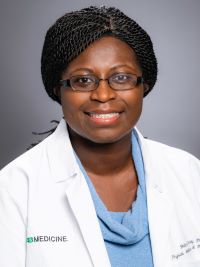
Assistant Professor
Areas of Interest
Stroke and Traumatic Brain Injury -
Brunner, Robert, M.D.
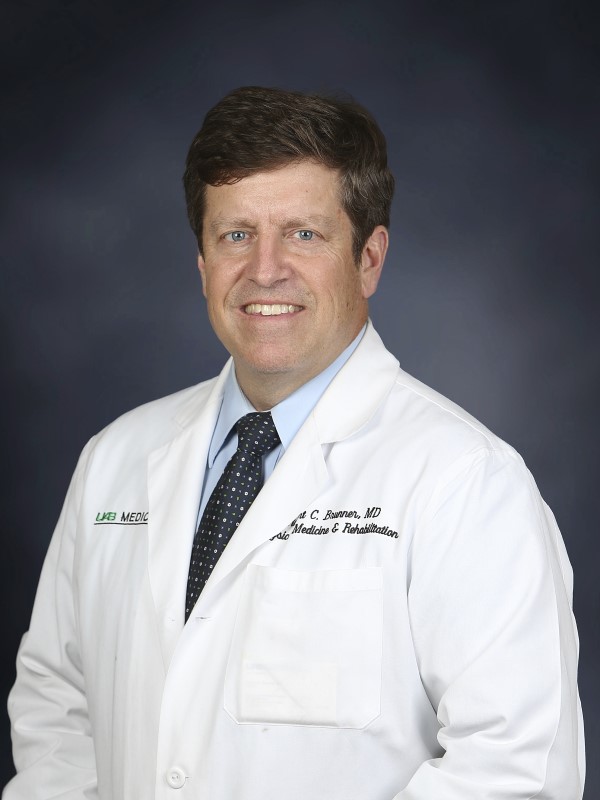
Professor
Vice Chair of Professional Development &Professor; Medical Director, Spain Rehabilitation Center; Medical Director, UAB Traumatic Brain Injury Model System; Director, Traumatic Brain Injury Patient ServicesAreas of Interest
Traumatic Brain Injury, Spasticity, Intrathecal Baclofen, Botox, Electromyography -
Chen, Yuying, M.D., Ph.D.
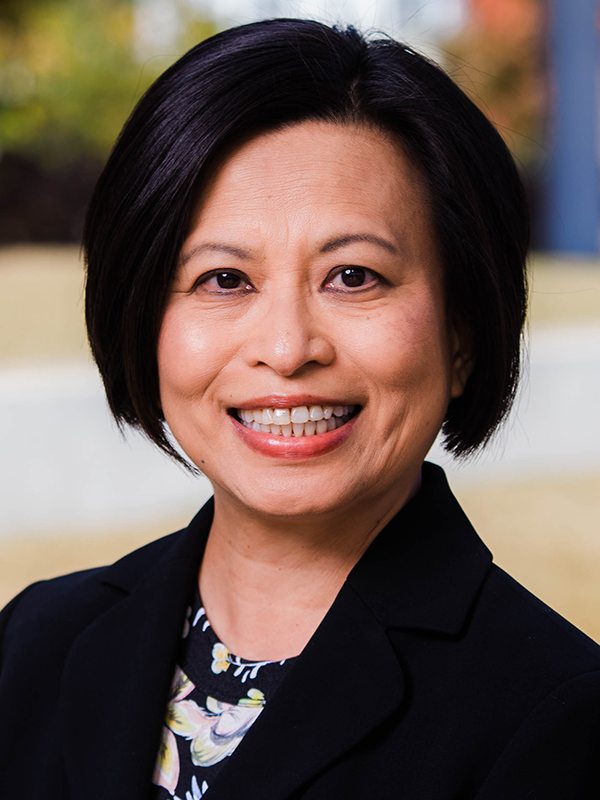 Professor
Professor
Director, National Spinal Cord Injury Statistical Center
Vice Chair of ResearchAreas of Interest
Spinal Cord Injury -
Colorado, Dale, D.O., M.P.H.

Associate Professor and Vice Chair of Education
Program Director, PM&R Residency
Medical Director, Sports and Musculoskeletal MedicineAreas of Interest
Sports and Musculoskeletal Medicine, Interventional Spine, Electrodiagnostic Medicine, Ultrasound, Adaptive Sports, Regenerative Medicine, and Performing Arts Medicine -
Cowan, Rachel E, PhD

Associate Professor
Project Director, UAB Spinal Cord Injury Model SystemAreas of Interest
Spinal Cord Injury, Exercise, Fitness, Activities of Daily Living, Wheelchairs, Mobility, Functional Independence, Outcome Measures -
Crash Risk Following Return to Driving After Moderate-to-Severe TBI: A TBI Model Systems Study
 The UAB Traumatic Brain Injury Model System (UAB-TBIMS) led a collaborative research study on crash risk following return to driving after moderate-to-severe TBI. Collaborative centers included the Virginia Traumatic Brain Injury Model System, Mayo Clinic Traumatic Brain Injury Model System, University of Washington Traumatic Brain Injury Model System, Moss Traumatic Brain Injury Model System, Rocky Mountain Regional Brain Injury System, Southeastern Michigan Traumatic Brain Injury System, and JFK Johnson Rehabilitation Institute.
The UAB Traumatic Brain Injury Model System (UAB-TBIMS) led a collaborative research study on crash risk following return to driving after moderate-to-severe TBI. Collaborative centers included the Virginia Traumatic Brain Injury Model System, Mayo Clinic Traumatic Brain Injury Model System, University of Washington Traumatic Brain Injury Model System, Moss Traumatic Brain Injury Model System, Rocky Mountain Regional Brain Injury System, Southeastern Michigan Traumatic Brain Injury System, and JFK Johnson Rehabilitation Institute.All eight TBI Model Systems sites conducted a phone survey to interview a total of 438 adults with TBI who returned to driving. The aim was to look at the number of motor vehicle crashes and risk factors of crashes for people after moderate-to-severe TBI. Participants were asked about their confidence in driving, driving ability, and history of crashes. Those interviewed were of different ages, time since injury, injury severity, sex, employment status, marital status, education levels, location, family income, and seizure history in the year prior to survey.
The study found that the people with TBI who participated in this study were 1.5 to 2.5 times more likely to be in crashes over a one-year timeframe when compared to the general population. Although the crash risk is higher following TBI than the general population, the results do not justify restricting people from driving after TBI as most people reported not having any crashes after their injury. However, there remains a need to identify and address factors that increase crash risk after TBI.
This study was funded by the National Institute on Disability, Independent Living, and Rehabilitation Research and published in the Journal of Head Trauma Rehabilitation .
-
Hollis, Sean D., Ph.D.
Associate Professor
Areas of Interest
Acquired Brain Injury -
Mark, Victor, M.D.

Associate Professor
Medical Director, Constraint-Induced Movement Therapy Research Programs and Clinic
Director, Scholarly Project Program and Geriatric Rehabilitation Lecture SeriesAreas of Interest
Neurologic Rehabilitation, Stroke, Multiple Sclerosis, Functional Neurological Disorder, Cognitive Disorders, Executive Dysfunction, Aphasia, Unilateral Spatial Neglect, Visual Attention, Cognitive Aging -
Marwitz, Jenny, M.A.

Instructor
Director, TBI ResearchAreas of Interest
Rehabilitation outcome, families, return to work, and emotional well-being following traumatic brain injury. -
PM&R Research Summary: Caregiver resilience six months after traumatic brain injury
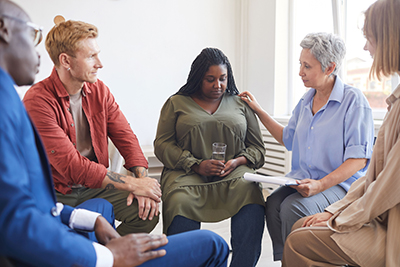 The UAB Traumatic Brain Injury Model System (UAB-TBIMS) conducts independent and collaborative research projects. The UABTBIMS was part of a recent collaborative research study on the resilience of caregivers at six months following traumatic brain injury (TBI). The Virginia Commonwealth Traumatic Brain Injury Model System led the multi-center study, and other participating centers included Mayo Clinic Traumatic Brain Injury Model System, Indiana Traumatic Brain Injury Model System, Rocky Mountain Regional Brain Injury System, and the Northern New Jersey Traumatic Brain Injury System.
The UAB Traumatic Brain Injury Model System (UAB-TBIMS) conducts independent and collaborative research projects. The UABTBIMS was part of a recent collaborative research study on the resilience of caregivers at six months following traumatic brain injury (TBI). The Virginia Commonwealth Traumatic Brain Injury Model System led the multi-center study, and other participating centers included Mayo Clinic Traumatic Brain Injury Model System, Indiana Traumatic Brain Injury Model System, Rocky Mountain Regional Brain Injury System, and the Northern New Jersey Traumatic Brain Injury System. -
PM&R researchers using simulator to assess return to driving after traumatic brain injury
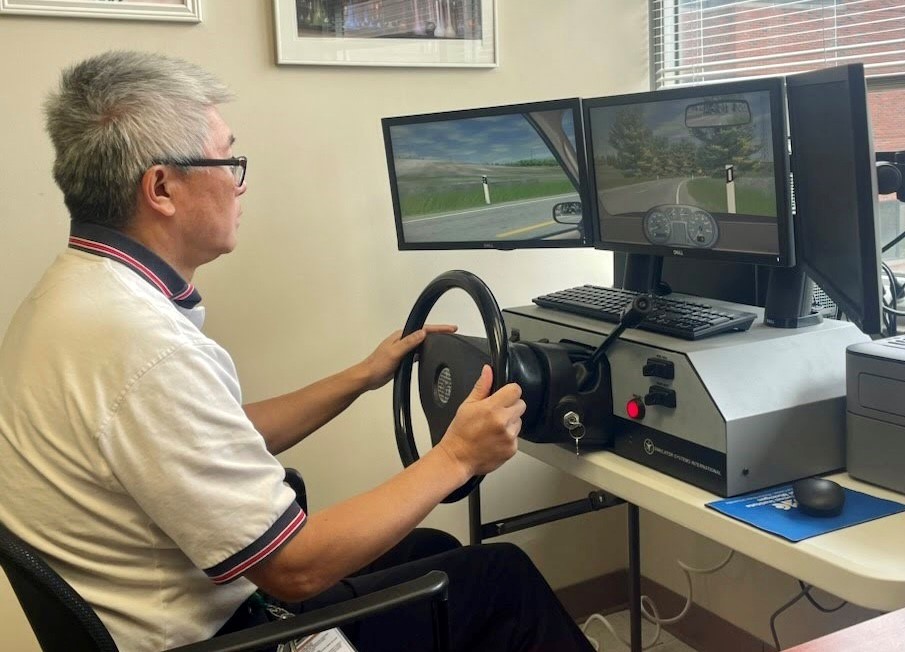 Driving is one of the hallmarks of a person’s independence, but people who experience moderate-to-severe traumatic brain injury (TBI) often have physical and cognitive deficits that limit their ability to return to driving. Such deficits might include response speed, maintenance of lane position, vehicle speed and stopping, response to distraction, attention to the roadway, identification of road hazards, and crash risk.
Driving is one of the hallmarks of a person’s independence, but people who experience moderate-to-severe traumatic brain injury (TBI) often have physical and cognitive deficits that limit their ability to return to driving. Such deficits might include response speed, maintenance of lane position, vehicle speed and stopping, response to distraction, attention to the roadway, identification of road hazards, and crash risk.A new study launched by researchers at the Department of Physical Medicine and Rehabilitation aims to look at the value of using a driving simulator to predict on-road driving performance after TBI.
“We know that most people who return to driving after a TBI do so safely, and it has an enormously positive impact on mental wellbeing, sense of independence, community reintegration along with health and function,” says Instructor Jenny Marwitz, project co-director and the department’s Director of TBI Research. “And we know that the most common driving assessments are typically not designed to identify specific safety concerns that a person with TBI might have. We want to see if a driving simulator built to identify deficits is a good option. Then, we can work with therapists to develop strategies to target deficits.”
The driving simulator chosen for the study is a compact and economical option for most rehabilitation centers to implement into clinical practice. It offers a series of driving scenarios designed as distinct modules to simulate a specific driving task, environment, or situation that increases in visual and strategic complexity of the environment and strategic control. Participants have a first-person point of view of the interior rearview mirror and dashboard, along with full left to right exterior field of view, with side mirrors.
“Another goal is the development of guidelines for clinicians to help people with TBI return to driving, and do it safely,” adds Marwitz. “We think the compact simulator can be a more accessible and affordable way to make that happen.”
This study is the site-specific research project of the UAB Traumatic Brain Injury Model System.
-
PM&R sees 55% increase in annual NIH research funding
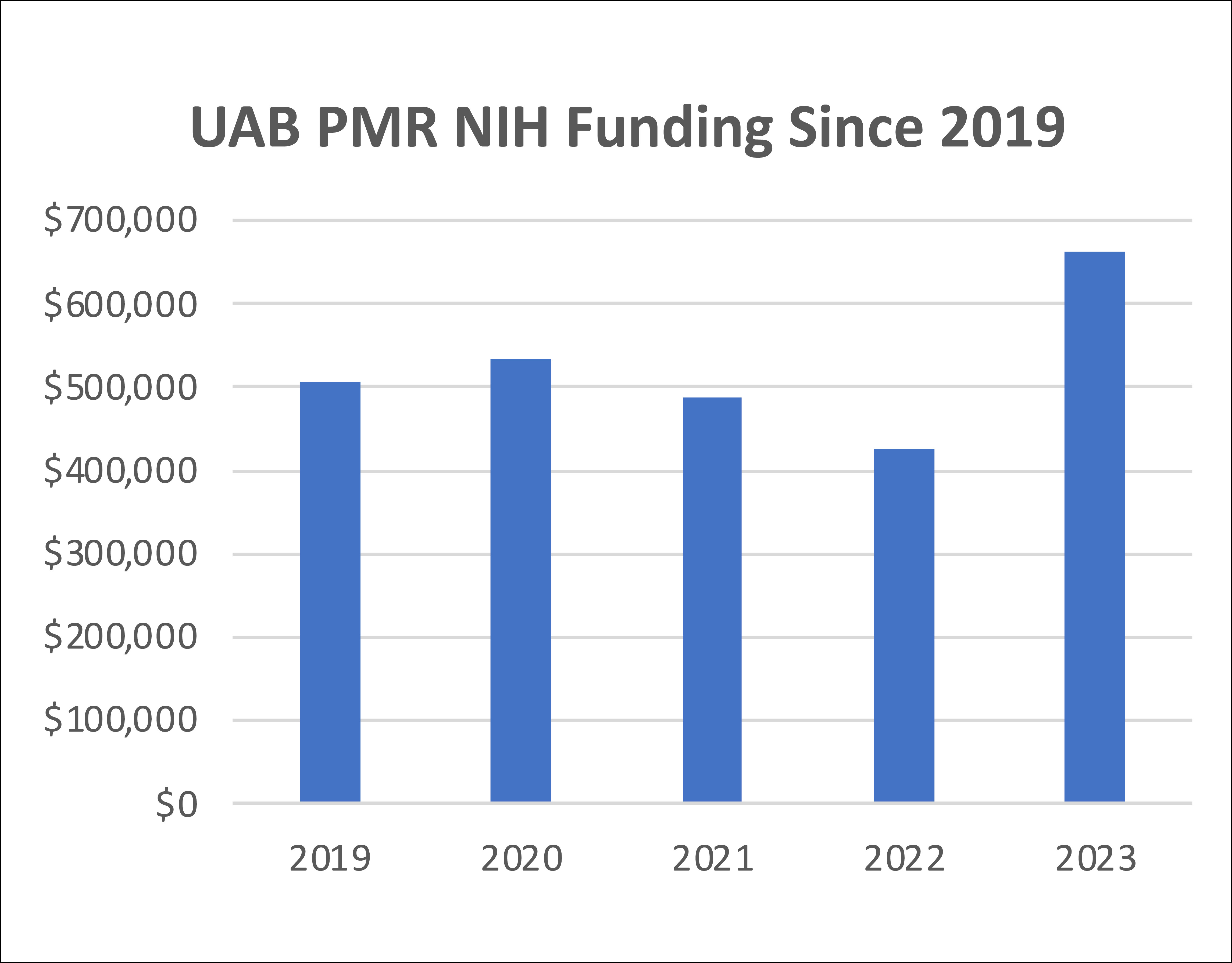 The Blue Ridge Institute for Medical Research has announced its annual rankings in National Institutes of Health (NIH) funding among Schools of Medicine along with funding by discipline for individual departments. In the latest 2023 report, the University of Alabama at Birmingham (UAB) Department of Physical Medicine and Rehabilitation (PM&R) ranks No.23 nationally among Departments of Physical Medicine and sees an increase in annual funding.
The Blue Ridge Institute for Medical Research has announced its annual rankings in National Institutes of Health (NIH) funding among Schools of Medicine along with funding by discipline for individual departments. In the latest 2023 report, the University of Alabama at Birmingham (UAB) Department of Physical Medicine and Rehabilitation (PM&R) ranks No.23 nationally among Departments of Physical Medicine and sees an increase in annual funding. -
Powell, Danielle, M.D.
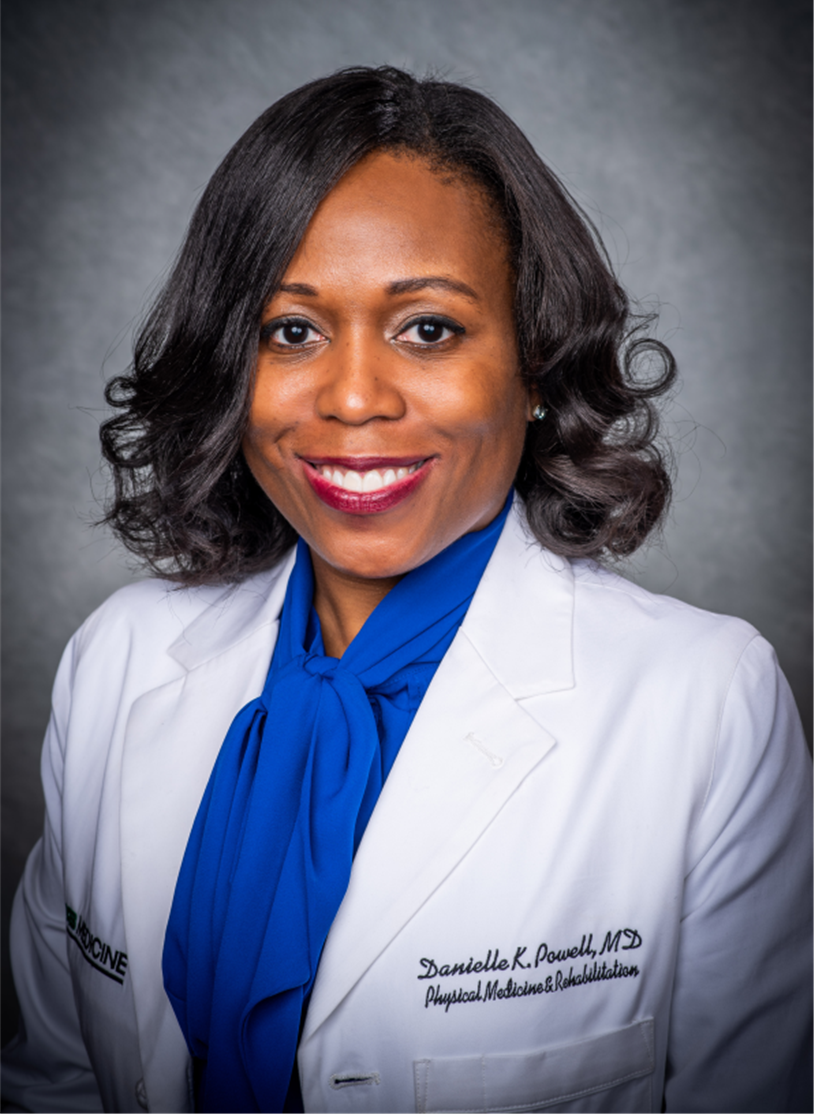
Associate Professor
Vice Chair of Clinical Affairs; Medical Director, Adult Multidisciplinary Spina Bifida Clinic; and Director of the PM&R Cancer Rehabilitation program.Areas of Interest
Spina Bifida, Cerebral Palsy, Cancer Rehab, Musculoskeletal Medicine, Botox, Electromyography -
Teranishi, Rachel, M.D.

Assistant Professor
Areas of Interest
Traumatic Brain Injury, Anoxic Brain Injury, Stroke, Spasticity, Botulinum Toxin -
Wilroy, Jereme D., Ph.D.
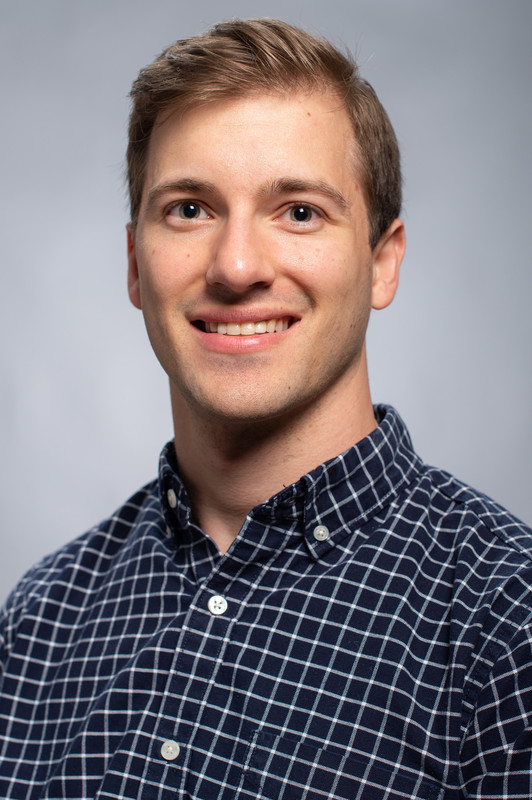
Associate Professor
Project Co-Director, UAB Spinal Cord Injury Model SystemAreas of Interest
Physical Disability, Spinal Cord Injury, Exercise, Adherence, Psychosocial Factors, Telehealth, eHealth, mHealth, Behavior Modification -
Zhou, Xiaohua, MD

Associate Professor
Areas of Interest
Stroke, Spasticity, CNS, Wound Care - Pressure Injuries, NCV/EMG, Botox Injection, Musculoskeletal
